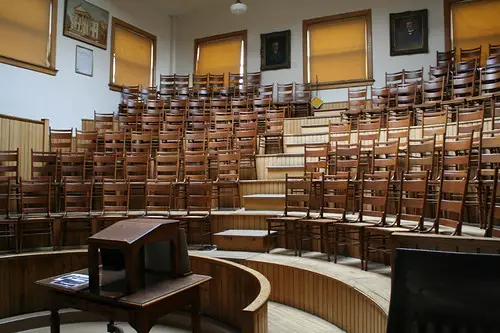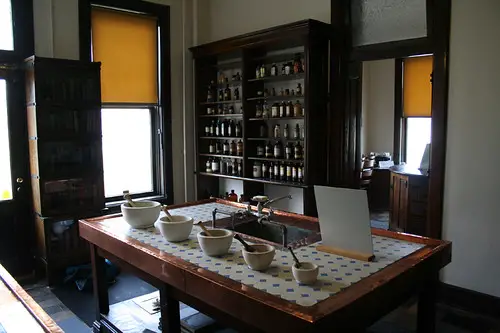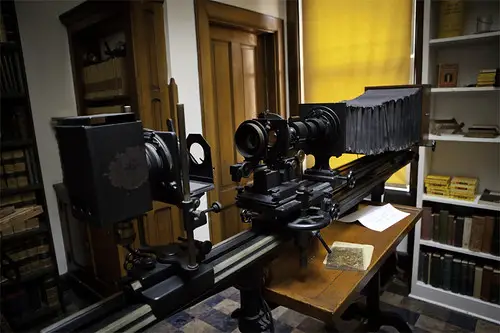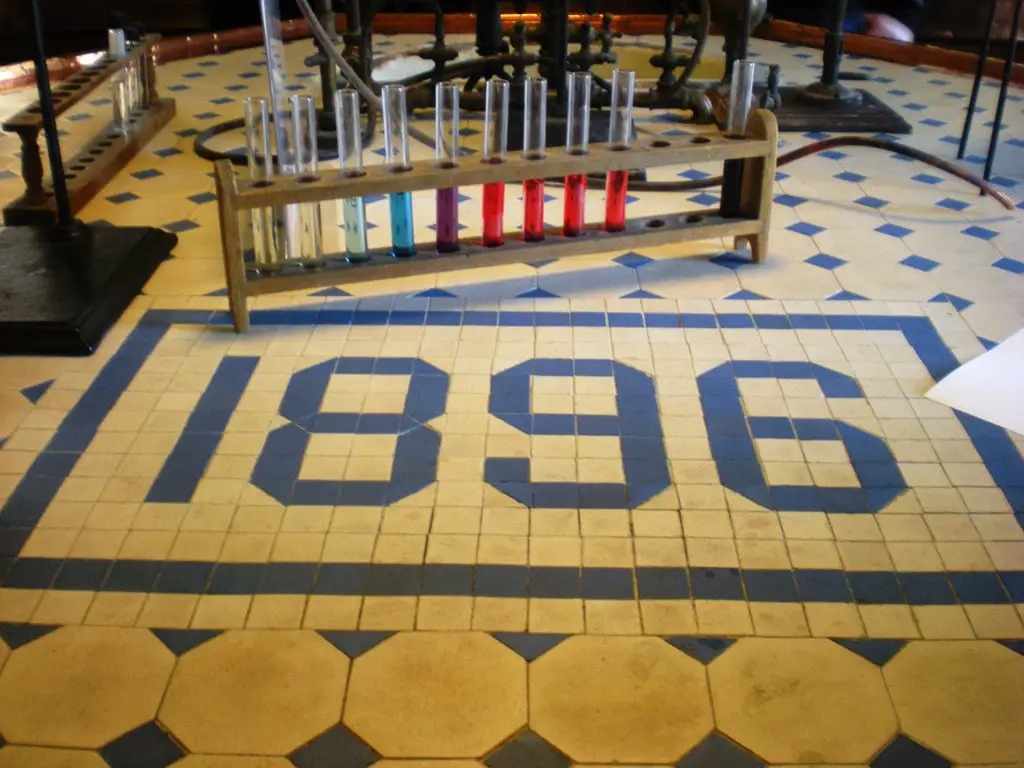Historical Foundations of the Indiana Medical History Museum
The Indiana Medical History Museum, an architectural and historical gem, stands on the grounds of the former Central Indiana Hospital for the Insane in Indianapolis.
This monument, a testament to the early strides in psychiatric medical research, finds its roots in the late 19th century.
The Old Pathology Building, the museum’s primary structure, was constructed in 1895 under the guidance of George F. Edenharter, the hospital’s administrator.
Edenharter, recognizing the need for advanced research and education in pathology, spearheaded this visionary project.
Architectural Brilliance and State-of-the-Art Design
Adolph Scherrer, a renowned architect known for his work on the Indiana State Capitol, was commissioned to design the building.
His expertise resulted in a two-story brick edifice considered state-of-the-art for its era. The building boasted a 150-seat teaching theater, a feature that underscored the institution’s commitment to medical education.
Additionally, it housed advanced bacteriological and chemical research facilities, a testament to the era’s scientific aspirations.
The hospital’s morgue, an anatomical museum, an autopsy room, mental research laboratories, and a photography room further emphasized its comprehensive role in medical research.
A Pioneering Institution in Psychiatric Research
From its inception, the Old Pathology Building was more than just a structure; it was a hub of medical innovation and education.
In the early 1900s, it became a pivotal site for the study of neurology and psychiatry, hosting lectures from the Central College of Physicians and Surgeons and the Medical College of Indiana until their merger with the Indiana University School of Medicine in 1908.
This collaboration continued until 1956, marking the building as a significant site for medical education in Indianapolis.
The focus on diseases like central nervous system syphilis, particularly prevalent in the 1920s and 1930s, positioned the institution at the forefront of psychiatric research.
The Indiana Medical History Museum, through its rich history and enduring architectural presence, remains a significant landmark in Indianapolis.
It commemorates the early efforts in psychiatric research and serves as one of the things to do in Indianapolis, Indiana, for those interested in medical history and heritage.
Educational Contributions and Medical Advancements
A Hub for Medical Education and Research
The Indiana Medical History Museum’s legacy is deeply intertwined with its role in medical education. At the turn of the 20th century, it became a pivotal center for studying neurology and psychiatry.
The Central College of Physicians and Surgeons and the Medical College of Indiana utilized the facility for lectures from 1900 to 1908.
This collaboration was a precursor to the eventual integration of these institutions into the Indiana University School of Medicine, a merger that expanded the museum’s educational impact until 1956.
The museum’s theater and laboratories became a crucible for medical students, who were introduced to groundbreaking topics in nervous system development, classifications of insanity, and the intricate workings of the brain and spinal cord.

Pioneering Research in Psychiatric Disorders
The museum’s significance was further cemented by its focus on central nervous system syphilis, particularly in the 1920s and 1930s.
This research was crucial, given the prevalence of the disease in psychiatric facilities at the time.
Walter Bruetsch, a notable figure in this field, led extensive studies, making the museum a national leader in this area of psychiatric research.
The findings from these studies contributed significantly to the understanding and treatment of the disease, marking a pivotal moment in medical history.
Enduring Educational Legacy
The museum’s role in medical education extended beyond lectures and research. It served as a practical learning site for students from nearby medical colleges, who would visit to observe autopsies and engage in hands-on learning.
This aspect of the museum’s operation highlights its comprehensive approach to education, blending theoretical knowledge with practical experience.
The legacy of these educational endeavors continues to resonate, underscoring the museum’s historical importance in medical science.
Transition to a Museum and Public Engagement
From Pathology Building to Public Museum
1969, a significant transformation occurred when the Old Pathology Building was repurposed into the Indiana Medical History Museum.
This transition marked a new chapter in the building’s history, shifting its focus from medical research to public education and preservation.
The museum opened to the public in 1984, offering weekly access to medical history. This change preserved the building’s architectural and historical significance and made its rich legacy accessible to a broader audience.

Expanding the Museum’s Collection and Reach
Operating as a not-for-profit organization, the museum began to amass an impressive collection of medical artifacts.
By 1994, it boasted over 15,000 items, ranging from medical equipment to historical documents.
While focusing on pathology, this collection encompasses various aspects of medical history.
In 1990, the museum expanded its public engagement by opening a gallery for rotating exhibits, allowing for diverse and dynamic medical history presentations.
Engaging with the Community and Media
The Indiana Medical History Museum has been a center for historical preservation and participating in cultural and media projects.
It received a federal grant in 2006 through the Indiana Department of Natural Resources, amounting to $44,100, for essential repairs.
The museum’s commitment to historic preservation was recognized in 2019 when the Old Pathology Building received a state historic marker from the Indiana Historical Bureau.
This accolade was a testament to the museum’s significance in Indiana’s cultural and historical landscape.
The marker was installed to celebrate the museum’s 50th anniversary, marking half a century of preserving and interpreting medical history.
These developments highlight the museum’s ongoing relevance and contribution to the local community and the broader cultural landscape.
The Museum’s Collections and Exhibits
A Treasure Trove of Medical Relics
The Indiana Medical History Museum is a custodian of a vast and varied collection of medical artifacts. This collection includes various pathological specimens, antique medical equipment, and historical documents.
The museum’s commitment to preserving these artifacts offers visitors a tangible connection to the past, providing insights into the evolution of medical science.

Diverse and Dynamic Exhibits
One of the museum’s most notable features is its rotating gallery, introduced in 1990. This space allows for thematic and varied exhibits, showcasing different aspects of medical history.
Visitors can explore exhibits ranging from the anatomical museum, which houses an array of human specimens, to the autopsy room, where many medical mysteries were unraveled.
The museum also features a photography room, where historical medical photographs and techniques are displayed, offering a glimpse into the visual documentation of medical history.
Film and Media Engagements
The Indiana Medical History Museum has also made its mark in film and media. The library within the museum served as a filming location for the movie “Eight Men Out,” highlighting the museum’s architectural and historical appeal.
This engagement with the media showcases the museum’s unique character and helps draw a diverse audience, furthering its educational mission.
Recent Developments and Community Impact
Grants and Community Projects
In recent years, the Indiana Medical History Museum has continued to evolve and engage with the community.
This grant was allocated for crucial plumbing repairs within the building, ensuring the preservation of its historical integrity.
The museum has also been involved in various community projects, including educational programs and public lectures, furthering its role as a center for learning and cultural engagement.
Engaging with the Broader Community
The Indiana Medical History Museum has become vital to the Indianapolis community. The museum has become a hub for those interested in medical history and heritage through its various exhibits, educational programs, and community events.
Its ongoing efforts to engage with the public, preserve history, and educate future generations underscore its importance as a cultural and educational institution in Indianapolis.

Challenges and Future Outlook
Navigating Contemporary Challenges
Like many historical institutions, the Indiana Medical History Museum faces its share of challenges. Key among these is the ongoing need for building maintenance and preservation.
The museum’s structure, dating back to 1895, requires continuous care to preserve its historical and architectural integrity.
Funding these efforts remains a constant challenge, necessitating grants, donations, and community support.
Additionally, the museum must adapt to the evolving landscape of museum curation and visitor engagement, balancing the need to modernize with the imperative to preserve its historical essence.
Expanding Educational and Research Opportunities
Looking to the future, the museum is poised to expand its role in medical education and public health awareness.
Plans include the development of new exhibits and educational programs that delve deeper into the history of psychiatry and medical research.
The museum aims to enhance its research capabilities, potentially collaborating with academic institutions and medical researchers.
These initiatives will enrich the museum’s offerings and reinforce its position as a vital resource in medical history.
Embracing Technological Advancements
In an age increasingly dominated by digital technology, the Indiana Medical History Museum recognizes the importance of integrating modern technology into its operations.
This includes enhancing its digital presence, developing virtual tours, and utilizing interactive exhibits to attract a broader, more tech-savvy audience.
The museum can extend its reach and impact locally and globally by embracing these technological advancements.

Conclusion
Reflecting on the Museum’s Historical Significance
The Indiana Medical History Museum is a testament to the early days of psychiatric medical research and education.
Its rich collection of medical artifacts and historical documents offers a unique window into the past, providing invaluable insights into the evolution of medical science and psychiatric care.
The museum preserves this history and makes it accessible to a wide audience, serving as an educational resource and a center for cultural engagement.
The Museum’s Role in the Community and Beyond
As the museum looks to the future, it continues to play a crucial role in the Indianapolis community and the broader field of medical history.
Its efforts in historic preservation, community engagement, and educational programming underscore its commitment to honoring the past while educating future generations.
The museum’s adaptability and resilience, particularly in contemporary challenges, will remain vital to Indiana’s cultural landscape for years.
A Beacon of Medical History and Heritage
In conclusion, the Indiana Medical History Museum is more than just a repository of medical artifacts; it is a beacon of medical history and heritage.
Its ongoing mission to preserve, educate, and engage makes it an invaluable asset to those in Indianapolis and anyone interested in medicine’s rich and complex history.
As the museum continues to evolve and grow, it stands as a shining example of how history can be preserved and shared in meaningful, impactful ways.
